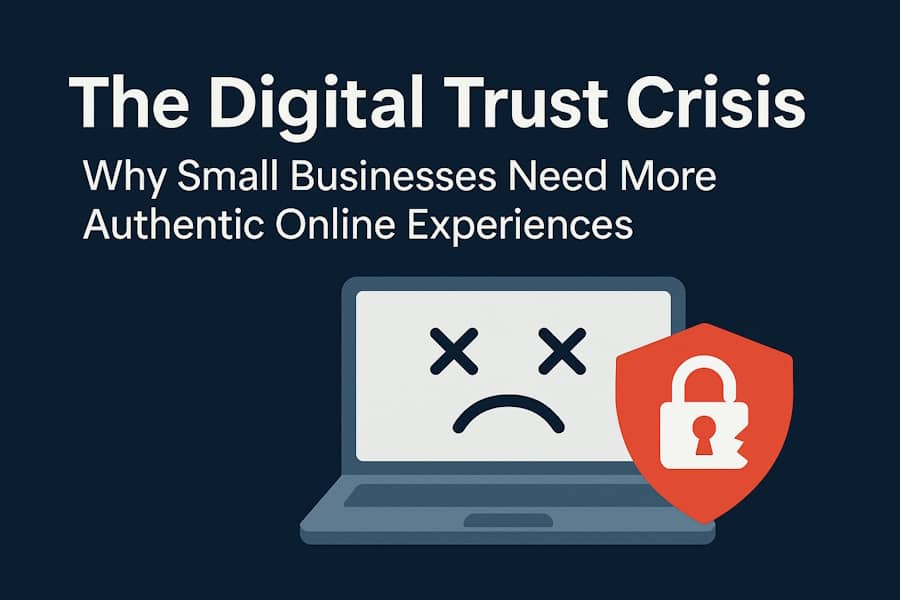Digital trust has become one of the most important drivers of online behavior. As more services, purchases, and interactions shift into digital channels, consumers are increasingly evaluating whether a business is credible, secure, and transparent before taking even the smallest action. Yet trust across the internet is declining at a pace many organizations have not fully recognized.
Small businesses face a particularly challenging landscape. They operate without the brand recognition, marketing budgets, or customer familiarity that larger companies rely on. When trust erodes online, the impact on smaller organizations is immediate: fewer inquiries, lower conversions, shorter visits, and increased skepticism from first-time visitors.
This article examines the current digital trust gap, why small businesses are disproportionately exposed, and how more authentic online experiences can help rebuild confidence.
Digital Trust Is Declining Faster Than Expected
Consumers have become more aware of how companies collect and use their data, but they often don’t feel adequately protected. Zscaler’s research highlights two important realities:
- 72% of Americans have little or no understanding of the laws that govern their data
- 90% of business executives believe customers trust them - while only 30% of consumers agree
This disconnect explains why trust is eroding even when businesses believe they are doing enough. Consumers feel exposed in a digital environment where they struggle to understand what happens to their personal information, how websites operate, and whether the businesses they encounter are legitimate.
Large brands can absorb this loss of trust because they benefit from long-standing reputations. Small businesses do not have the same margin of safety. When a customer encounters an unfamiliar brand with a new website, the trust assessment begins immediately - and it is often unforgiving.
Why Small Businesses Are More Vulnerable
Digital trust does not erode evenly across all business types. Smaller organizations face unique disadvantages:
Limited brand familiarity
Customers frequently visit small-business websites for the first time without prior exposure. With no pre-existing relationship or brand reputation, the website must communicate credibility on its own.
Generic digital experiences
Many small businesses rely on templated websites, stock photography, or AI-generated content. While cost-effective, these approaches often produce experiences that feel indistinguishable from thousands of others.
When everything looks the same, trust decreases.
Higher sensitivity to poor user experience
Minor issues - a confusing layout, unclear messaging, slow performance, outdated visuals - can lead users to question the legitimacy of the business itself.
Limited resources for recovery
If a larger organization suffers from declining trust, it can invest in marketing, PR, reputation repair, or design improvements. Smaller companies often cannot. A trust break can take years to overcome.
These factors create a challenging environment where even small design or communication decisions meaningfully affect how customers perceive the business.
Why Authentic Online Experiences Matter More Than Ever
As digital trust declines, customers have become more selective about the businesses they interact with online. They’re not just evaluating the product or service - they’re evaluating whether the digital experience feels credible, intentional, and genuinely representative of the business behind it.
Authenticity matters because it helps users quickly understand who they’re dealing with. When a website feels generic, automated, or unclear, visitors assume the business operates the same way. When it feels human, consistent, and transparent, trust forms more easily.
For small businesses competing in crowded markets, authenticity has become a practical advantage. It differentiates them from competitors using the same templates, and it reassures customers that the business is real, reliable, and worth engaging with. The next sections break down how authenticity is communicated through clarity, design, performance, transparency, and alignment across digital touchpoints.
Clarity and Transparency Build Stronger Trust
Zscaler’s research emphasizes a growing expectation for transparency, especially around data usage, communication processes, and the claims businesses make about their products or services.
On a small-business website, strong transparency includes:
- clear service descriptions
- straightforward explanations of pricing or engagement steps
- visible policies written in plain language
- honest expectations about timelines or deliverables
- avoidance of exaggerated marketing claims
Customers don’t expect a small business to behave like a global enterprise, but they do expect the fundamentals of clarity. When information is easy to understand and clearly explained, trust naturally increases.
Human-Centered Design Helps Users Feel Connected
Authenticity is not solely a communication challenge - it is also a design challenge. The way a website looks, feels, and behaves directly affects whether visitors perceive it as credible.
Human-centered design supports trust by emphasizing:
- real photography instead of overly polished stock images
- copy that sounds like it was written by a person, not a template
- consistent brand voice across all pages
- intuitive navigation and predictable interactions
- interface elements that match user expectations
This is often where small businesses struggle. They may rely on “quick-build” options that generate a usable layout but do not reflect the personality, values, or experience of the actual business. Over time, this results in a website that works mechanically but not emotionally.
For example, agencies like Mendel Sites focus on building websites that communicate trust visually and structurally - not through gimmicks, but through clarity, thoughtful visuals, and experience design that reflects the business behind the interface. This type of intentional, human-centered approach is increasingly important as consumers learn to differentiate between generic templates and genuinely crafted experiences.
Performance and Reliability Shape User Perception
Speed and performance play an underestimated role in trust.
When a website loads slowly, fails to respond, or displays broken elements, users instinctively associate the business with inefficiency or lack of professionalism. Even if this assumption is unfair, it happens quickly and subconsciously.
Key trust-building performance signals include:
- fast page load times
- mobile responsiveness
- predictable navigation
- consistent layout structure
- functional buttons and forms
Trust is partially a technical issue. If the digital experience feels unreliable, users question the reliability of the business as well.
Consistency Across Touchpoints Reinforces Credibility
Trust is cumulative. It forms across multiple interactions, not just one.
Consistency between:
- website
- social media profiles
- online reviews
- email communications
- branding
- tone and messaging
is essential. When customers see different information or quality levels across these channels, trust weakens. Consistency signals that the business is organized, stable, and accountable - qualities customers value highly.
Small businesses benefit significantly from investing in alignment because every touchpoint reinforces the next. When a customer encounters consistency, they feel more confident moving forward with a purchase or inquiry.
Ethical Communication Strengthens Long-Term Trust
Ethical marketing practices have become more important as consumers grow skeptical of exaggerated claims or deceptive tactics. Trust is strengthened when businesses:
- avoid manipulative countdown timers
- resist using misleading “limited time” offers
- present pricing honestly
- communicate openly about risks or deliverables
- avoid hidden fees
- give users control over their data
These principles matter even more in an environment where AI-generated content and automated sales funnels are becoming more common. Ethical communication is often the clearest indicator that a business values long-term relationships over short-term gains.
The Cost of Neglecting Digital Trust
When trust breaks, the consequences are immediate and difficult to reverse:
- reduced site engagement
- lower conversion rates
- higher bounce rates
- fewer inquiries
- lower retention
- weaker word-of-mouth referrals
- difficulty differentiating from competitors
Even if the underlying product or service is strong, a poor digital experience can block customers before they ever reach the value the business provides.
The problem is not usually intent. Most small businesses are trustworthy, but their digital environments fail to communicate that trust effectively.
A Practical Framework for Improving Digital Trust
Small businesses can improve digital trust by focusing on practical, manageable changes that enhance authenticity.
Audit for Trust Signals
Review the digital experience from an unbiased perspective:
- Is the value proposition clear?
- Are services explained simply?
- Is the design consistent?
- Does anything look outdated or generic?
- Are trust signals (testimonials, reviews, certifications) visible?
This helps identify where improvements are needed.
Strengthen Transparency
Add clarity to areas that typically raise questions:
- explain how the business works
- clarify next steps after inquiries
- provide visibility into pricing or timeframes
- simplify privacy information
- avoid ambiguous language
Clear communication removes uncertainty - one of the biggest drivers of mistrust.
Humanize the Digital Experience
Replace or revise:
- stock photos
- generic headlines
- AI-generated paragraphs
- boilerplate “about” sections
With:
- real content
- original examples
- genuine language
- visuals that reflect the actual business
Authenticity is most powerful when it feels lived-in rather than manufactured.
Improve Technical Experience
Ensure the site is:
- fast
- mobile-friendly
- accessible
- error-free
- easy to navigate
Visitors should not need to think about using the website. When the experience is frictionless, trust increases automatically.
Align All Communication Channels
Review and update:
- business listings
- social profiles
- messaging frameworks
- visual identity
- calls-to-action
Consistency reassures users that the business is legitimate and organized.
Highlight Social Proof and Credible Evidence
Customers trust:
- testimonials
- reviews
- case studies
- press mentions
- before-and-after examples
- performance metrics
Authentic social proof is one of the strongest trust-builders available to small businesses.
Why Authenticity Has Become a Competitive Advantage
As the digital environment becomes more automated, more templated, and more algorithm-driven, authenticity has become a scarce resource. Consumers are increasingly able to detect when a website or brand experience feels overly generic or artificially generated.
Authenticity is now a differentiator because:
- it is difficult to automate
- it requires genuine insight
- it reflects real business identity
- it creates emotional certainty
- it stands out among mass-produced digital experiences
Small businesses that invest in authenticity are better positioned to gain trust quickly - and trust drives action, referrals, and long-term loyalty.
Why This Matters Now
Digital trust is declining across industries, and small businesses are disproportionately affected. Consumers are more cautious, more informed, and more selective about who they choose to engage with online. To remain competitive in this environment, businesses need digital experiences that feel credible, transparent, and human.
Authentic online experiences are not just an aesthetic preference - they are essential components of modern trust-building. By strengthening transparency, improving the user experience, aligning communication channels, and emphasizing ethical and human-centered practices, small businesses can create environments where customers feel confident moving forward.
Trust may be more difficult to earn today, but it is still achievable. And for businesses that invest in authenticity, it becomes a meaningful advantage in a competitive digital world.








